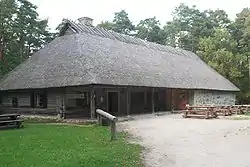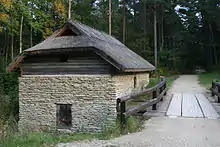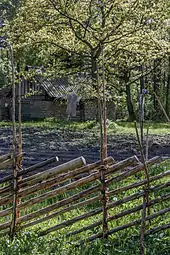Estonian Open Air Museum
The Estonian Open Air Museum (Estonian: Eesti Vabaõhumuuseum) is a life-sized reconstruction of an 18th-century rural/fishing village, which comes complete with church, inn, schoolhouse, several mills, a fire station, twelve farmyards and net sheds. The site spans 72 hectares of land and contains about 80 separate buildings and is located 8 km to the west of Tallinn city center at Rocca al Mare. Established in 1957, the museum showcases 68 farmhouses assembled into twelve farmyards from North, South and West Estonia.
Eesti Vabaõhumuuseum | |

| |
| Established | 1957 |
|---|---|
| Location | shore of Kopli Bay near Tallinn, Estonia |
| Type | History museum |
| Director | Merike Lang |
| Website | www |
Along with the farmyards, old public buildings are arranged singularly and in groups in a way that represents an overview of Estonian vernacular architecture of the past two centuries.
The plans for founding the museum were first discussed in 1913,[1] when Estonian literati, inspired by Scandinavian open-air museums, wanted to establish such a museum in Estonia.[2]
Gallery
 The oldest farmstead in the museum: Sassi Jaani (18-19th. century)
The oldest farmstead in the museum: Sassi Jaani (18-19th. century) Sutlepa chapel, 19th century
Sutlepa chapel, 19th century Jüri Jaagu farmstead, 19th century
Jüri Jaagu farmstead, 19th century Kutsari Härjapea farmstead, 1930s
Kutsari Härjapea farmstead, 1930s Kolu tavern, 19th century
Kolu tavern, 19th century Kahala Water Mill, 19th century
Kahala Water Mill, 19th century 19th century farm house
19th century farm house 19th century farm house
19th century farm house Summer kitchen, during the winter cooking was done within the main farm house
Summer kitchen, during the winter cooking was done within the main farm house Estonian Sauna
Estonian Sauna Farm house kiln, used to dry grain during the wet autumn and heating and cooking in winter
Farm house kiln, used to dry grain during the wet autumn and heating and cooking in winter Sassi Jaani farmstead
Sassi Jaani farmstead Farmhouse store room
Farmhouse store room
 19th century farm house
19th century farm house Roundpole fence
Roundpole fence
References
- Muuseumist Archived 2012-01-03 at the Wayback Machine (in Estonian)
- Stephen J. Kelley (2000). Wood structures: a global forum on the treatment, conservation, and repair of cultural heritage. ASTM International. p. 96. ISBN 0-8031-2497-X.